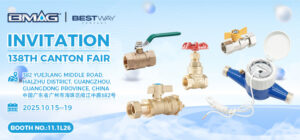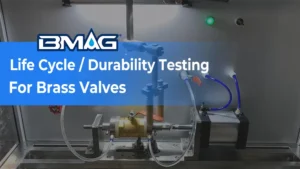Tabla de contenido
Palanca1. Por qué probar la válvula Material?
La prueba de material de las válvulas de latón constituye una piedra angular de garantía de calidad, diseñado para validar las características de integridad y rendimiento del material base. Los objetivos principales son:
- Verificación del cumplimiento: Para confirmar que la composición química del material y las propiedades mecánicas se adhieren estrictamente a los estándares internacionales especificados (P.EJ., ASTM, EN) y requisitos técnicos específicos del cliente. Esto incluye una verificación rigurosa de elementos restringidos, como el plomo (Pb), particularmente para aplicaciones de agua potable.
- Garantía de rendimiento y confiabilidad: Para determinar que el material posee la resistencia a la tracción necesaria, dureza, ductilidad, y resistencia a la corrosión para resistir las presiones de diseño, temperaturas, y medios fluidos a lo largo de su ciclo de vida operativo, mitigando así el riesgo de falla prematura.
- Evaluación de la integridad microestructural: Examinar el material a nivel microscópico para discontinuidades internas como la porosidad, inclusiones, micro-cracks, o estructuras de fase adversas que no son detectables por inspección visual pero pueden comprometer severamente la integridad estructural del componente.
- Control de procesos de fabricación: Proporcionar comentarios críticos sobre la eficacia de los procesos termomecánicos, incluyendo casting, forja, y tratamiento térmico. La microestructura del material sirve como un indicador directo del control de los parámetros del proceso y la consistencia.

2. Material de la válvula de latón Estándares de prueba
Para garantizar que las pruebas sean consistentes y significativas en todas partes del mundo., seguimos un conjunto de reconocidos internacionalmente “libros de reglas,” o estándares. Estos documentos definen exactamente qué probar y qué resultados son aceptables.. Los estándares clave para las válvulas de latón incluyen:
- Normas para la composición química:
- ASTM (Sociedad Americana de Pruebas y Materiales): Estándares como ASTM B283 yASTM B16 Definir el porcentaje preciso de cobre, zinc, dirigir, y otros elementos para aleaciones de latón específicas (P.EJ., C36000).
- EN (Norma europea): Los estándares como EN 12164 y EN 12165 son el equivalente europeo, Definición de aleaciones populares como CW617N(un latón especial resistente a un tipo de corrosión llamado dezincificación).
- Normas para propiedades mecánicas (El “Fortaleza”):
- Los mismos documentos ASTM y EN también especifican la resistencia mecánica requerida, dureza, y flexibilidad del material.
- Normas para la estructura interna & Pruebas especiales:
- ASTM E3 & E112: Estos nos guían sobre cómo preparar una muestra para el examen microscópico y cómo medir el tamaño de sus cristales internos. (granos).
- YO ASI 6509: Esta es una prueba de corrosión crucial, Específicamente para verificar qué tan bien el latón se resiste a la dezincificación, Un factor de rendimiento clave para las válvulas en los sistemas de agua.
3. Principios de muestreo: Como nosotros Elija muestras de válvula de latón?
No podemos probar cada pieza de material de la válvula de latón, Por lo tanto, debemos seleccionar pequeñas muestras que representen con precisión todo el lote. Este proceso es crítico para resultados confiables.
- El principio de representación: Tomamos algunas muestras de un lote grande según un plan estratégico.. Es similar a que un médico tome una pequeña muestra de sangre para comprender la salud general de una persona.. Una buena muestra cuenta la historia de todo el lote.
- Donde tomar la muestra: La ubicación importa. Las muestras generalmente se cortan de áreas donde los defectos tienen más probabilidades de ocurrir, como los extremos de una barra de latón cruda o la sección más gruesa de un cuerpo de válvula terminada. Esto asegura que estamos probando los puntos más débiles.
- La trazabilidad es clave: Cada muestra está cuidadosamente etiquetada con una identificación única que la vincula a su lote original, fecha de producción, y proveedor. Por aquí, Si encontramos un problema, Sabemos exactamente qué productos se ven afectados.

4. Métodos de prueba de núcleo: Análisis metalográfico
Utilizamos varios métodos para comprender completamente el material de la válvula.. Lo más revelador es a menudo el análisis microscópico.
Piense en esto como ciencia forense para metales. Preparamos una pequeña muestra para revelar su interna “huella dactilar” bajo un potente microscopio. Esto nos dice más que cualquier otra prueba sobre la historia del material y la verdadera calidad.. Esto es lo que buscamos y cómo lo hacemos:

- Lo que buscamos:
- Estructura cristalina (Granos): Todos los metales están hechos de pequeños cristales llamados granos. En general, bien, Los granos bien empaquetados hacen que el latón sea fuerte y resistente. Grande, Los granos irregulares pueden ser un signo de debilidad causado por una calefacción inadecuada durante la fabricación.
- Defectos internos: Esta es una búsqueda directa de defectos microscópicos que son invisibles a simple vista. Buscamos pequeñas burbujas de aire (porosidad), grietas, impurezas no metálicas (inclusiones), u otras imperfecciones que podrían hacer que la válvula se filtre o se rompa bajo presión.
- Forjando líneas de flujo: Cuando se forja el latón (con forma de presión), sus granos internos se alinean para crear “líneas de flujo.” Idealmente, Estas líneas deben ser suaves y seguir la forma de la válvula., como el grano en un trozo de madera. Cualquier rotura o giros agudos en estas líneas indica un punto débil estructural.
- Como se hace (El proceso de 5 pasos):
- Cortar & Montar: Una pieza pequeña se corta cuidadosamente de la válvula o la materia prima.. Luego está montado en un disco de resina duro, Como un insecto atrapado en ámbar, Para facilitar la manipulación.
- Moler & Polaco: La superficie de la muestra es molida y luego se pule con materiales abrasivos más finos y finos hasta que se convierta en un perfecto, Espejo sin rascar.
- Grabar al agua fuerte: Se aplica una solución química suave a la superficie similar a la espejo durante unos segundos. Este “grabado” la superficie, Actuar como un tinte que revela los límites entre los granos y otras características microestructurales.
- Observar: La muestra grabada se coloca bajo un microscopio metalúrgico de alta potencia.
- Analizar: Un experto capacitado examina la imagen magnificada, Identificar la estructura de grano, Buscando defectos, y tomar fotos como un registro permanente.
- Análisis químico: Usamos una máquina llamadaEspectrómetro, que vaporiza un pequeño lugar en el metal con una chispa. Analizando la luz de esa chispa, Puede decirnos instantáneamente la receta química exacta del latón a una fracción de un porcentaje.
- Prueba mecánica:
- Prueba de tracción: Una muestra de forma estándar se separa en unMáquina de prueba universal Hasta que se rompe. Esto mide suresistencia a la tracción (cuánta fuerza puede tomar), fuerza de rendimiento (el punto en el que comienza a deformarse permanentemente), yductilidad (cuánto puede estirarse antes de romperse).
- Prueba de dureza: Usamos unProbador de dureza para presionar un pequeño, punta dura en la superficie del material. Midiendo el tamaño o la profundidad de la sangría, obtenemos una medida rápida y confiable de su resistencia al rascado y al desgaste..

5. Método de prueba primario: Espectrometría de emisión óptica (OES)
- Principio y ventajas: El método predominante utilizado en la industria para su velocidad, exactitud, y la precisión esEspectrometría de emisión óptica (OES), comúnmente conocido como chispa. El principio implica generar una chispa eléctrica de alto voltaje entre un electrodo y la superficie de la muestra. Esta chispa vaporiza una pequeña cantidad del material, excitar sus átomos a los estados de mayor energía. A medida que estos átomos regresan a su estado fundamental, emiten luz a longitudes de onda características únicas de cada elemento: un elemental “huella dactilar.” El espectrómetro dispersa esta luz y mide la intensidad de cada longitud de onda característica para calcular la concentración de porcentaje precisa de cada elemento en la muestra. Sus ventajas clave incluyen un análisis rápido (típicamente debajo 30 artículos de segunda clase), alta precisión, y la capacidad de analizar múltiples elementos simultáneamente.
- Procedimiento de prueba:
- Preparación de muestra: Se corta un espécimen de la materia prima o la válvula terminada. La superficie a analizar es molida y suave con un torno o papel abrasivo para eliminar los óxidos, revestimiento, o contaminación superficial, Asegurar una lectura precisa.
- Calibración de instrumentos: Antes del análisis, El espectrómetro se calibra usandoMateriales de referencia certificados (CRMS) que tiene una matriz similar a la muestra que se está probando. Este paso asegura la precisión y estabilidad del instrumento..
- Ejecución de la prueba: La muestra preparada se coloca en el soporte de chispa del espectrómetro, y el ciclo de análisis se inicia. El instrumento realiza automáticamente el chisporro., adquisición de luz, y procesamiento de datos.
- Interpretación de resultados: El informe de composición química resultante se compara directamente con los límites definidos en el estándar aplicable, comoMesa 1 de ASTM B16. La concentración de cada elemento debe caer dentro del rango mínimo y máximo especificado para considerarse conforme.
La composición química del material de la válvula de latón C36000se ajustará a los requisitos elementales especificados enMesa 1 de ASTM B16.

6. Equipo de prueba
Para realizar estas pruebas con precisión, Es necesario equipos especializados:
- Espectrómetro: Un instrumento para análisis de composición química rápida y precisa.
- Máquina de prueba universal: Una máquina poderosa que realiza pruebas de tracción al separar los materiales para medir su resistencia y flexibilidad.
- Probador de dureza: Un dispositivo para medir la dureza de la superficie del material.
- Equipo de laboratorio metalúrgico: Esto incluye cortadores de precisión, prensas de montaje, molinillo, y una alta potenciaMicroscopio metalúrgico con una cámara y software de análisis: el conjunto de herramientas completo para realizar análisis metalográficos.

7. Análisis de causa raíz de no conformidades
Se inicia una investigación sistemática tras la detección de cualquier resultado de la prueba de material no conforme para identificar la causa fundamental.
- Desviaciones de composición química: Atribuible a la recepción de un grado de material incorrecto de un proveedor, Errores de cálculo de carga, o pérdida elemental no controlada durante las operaciones de fundición.
- Propiedades mecánicas deficientes: A menudo una consecuencia directa de una historia termomecánica inadecuada, tales como temperaturas de forja incorrectas, deformación inadecuada, o ciclos de tratamiento térmico incorrectos, que dan como resultado una microestructura subóptima.
- Defectos microestructurales: Evidencia metalográfica de porosidad, inclusiones, o cracks apunta a deficiencias en el casting, forja, o procesos de fabricación de materias primas. La naturaleza y la ubicación del defecto proporcionan información crítica para la investigación.
8. Manejo de material no conforme
Un procedimiento operativo estándar formal (COMPENSACIÓN) gobierna el manejo de materiales que no cumplen con las especificaciones.
- Segregación e identificación: El material no conformado se segregue inmediatamente de todos los stock conforme y se coloca en un área de cuarentena designada. Se identifica notablemente con etiquetas sin conformidad que detallan el número de lote, cantidad, y razón para el rechazo.
- Junta de revisión de material (HOLA) Disposición: Un equipo interfuncional que compuesto por representantes de la calidad, Ingeniería, y la producción se reúne para revisar los datos de la prueba y el informe de no conformidad.
- Acciones de disposición: El MRB determina la disposición final, que puede incluir una de las siguientes acciones:
- Chatarra: El material se considera inutilizable y designado para el reciclaje.. Esta es la acción requerida para defectos críticos.
- Rehacer / Volver a procesar: Aplicable solo si la no conformidad se puede rectificar (P.EJ., a través del tratamiento de nuevo calor para la corrección de dureza). Cualquier material reelaborado debe someterse a una prueba completa para la verificación..
- Volver al proveedor (RTV): Si la causa raíz se remonta al proveedor, el material es rechazado y devuelto, Acompañado por una solicitud de acción correctiva del proveedor formal (CICATRIZ).






